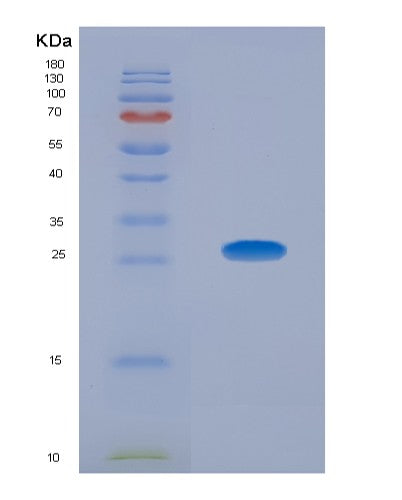Astor Scientific | SKU:
ASTP8399
22% off
Human CDK5 (Cyclin-Dependent Kinase 5) - Recombinant Protein
Molecule: CDK5
Species: Human
Expression System: E.coli
Tag: N-6His
Expression Range: 92-273aa
Species: Human
Expression System: E.coli
Tag: N-6His
Expression Range: 92-273aa
$429.99
$549.99
Unit price
/
Unavailable
Shipping calculated at checkout.
- 100ug
No reviews

Human CDK5 (Cyclin-Dependent Kinase 5) - Recombinant Protein
$429.99
$549.99
Unit price
/
Unavailable
Payment & Security
Payment methods
Your payment information is processed securely. We do not store credit card details nor have access to your credit card information.
Product Description
Product Overview
| Product Name | Recombinant Human Cyclin Dependent Kinase 5 (CDK5) Protein |
| Product Overview | This recombinant human Cyclin Dependent Kinase 5 (CDK5) protein includes amino acids 92-273aa of the target gene is expressed in E.coli.The protein is supplied in lyophilized form and formulated in phosphate buffered saline (pH7.4) containing 0.01% sarcosyl, 5% trehaloseprior to lyophilization. |
| Target Uniprot Id | Q00535 |
| Recommended Name | Cyclin-dependent kinase 5 |
| Gene Name | CDK5 |
| Synonyms | Cyclin-dependent kinase 5, PSSALRE |
| Species | Human |
| Predicted Molecular Mass | 27 kDa |
| Expression System | E.coli |
| Expression Range | 92-273aa |
| Tag | N-6His |
| Purity | >85% |
| Formulation | Lyophilized |
| Buffer | Phosphate buffered saline (pH7.4) containing 0.01% sarcosyl, 5%Trehalose |
| Storage Condition | 1. Store at -20°C/-80°C upon receipt, aliquoting is necessary for mutiple use. 2. Avoid repeated freeze-thaw cycles. 3. Store working aliquots at 4°C for up to one week. 4. In general, protein in liquid form is stable for up to 6 months at -20°C/-80°C. Protein in lyophilized powder form is stable for up to 12 months at -20°C/-80°C. |
| Reconstitution Instruction | Briefly centrifuged the vial prior to opening to bring the contents to the bottom. Reconstitute protein in deionized sterile water to a concentration of 0.1-1.0 mg/mL. It is recommended to add 5-50% of glycerol (final concentration) and aliquot for long-term storage at -20°C/-80°C. The default final concentration of glycerol is 50%. |
| Applications | Positive Control; Immunogen; SDS-PAGE; WB |
| Research Area | Cell Biology |
| Target Function | Proline-directed serine/threonine-protein kinase essential for neuronal cell cycle arrest and differentiation and may be involved in apoptotic cell death in neuronal diseases by triggering abortive cell cycle re-entry. Interacts with D1 and D3-type G1 cyclins. Phosphorylates SRC, NOS3, VIM/vimentin, p35/CDK5R1, MEF2A, SIPA1L1, SH3GLB1, PXN, PAK1, MCAM/MUC18, SEPT5, SYN1, DNM1, AMPH, SYNJ1, CDK16, RAC1, RHOA, CDC42, TONEBP/NFAT5, MAPT/TAU, MAP1B, histone H1, p53/TP53, HDAC1, APEX1, PTK2/FAK1, huntingtin/HTT, ATM, MAP2, NEFH and NEFM. Regulates several neuronal development and physiological processes including neuronal survival, migration and differentiation, axonal and neurite growth, synaptogenesis, oligodendrocyte differentiation, synaptic plasticity and neurotransmission, by phosphorylating key proteins. Activated by interaction with CDK5R1 (p35) and CDK5R2 (p39), especially in post-mitotic neurons, and promotes CDK5R1 (p35) expression in an autostimulation loop. Phosphorylates many downstream substrates such as Rho and Ras family small GTPases (e.g. PAK1, RAC1, RHOA, CDC42) or microtubule-binding proteins (e.g. MAPT/TAU, MAP2, MAP1B), and modulates actin dynamics to regulate neurite growth and/or spine morphogenesis. Phosphorylates also exocytosis associated proteins such as MCAM/MUC18, SEPT5, SYN1, and CDK16/PCTAIRE1 as well as endocytosis associated proteins such as DNM1, AMPH and SYNJ1 at synaptic terminals. In the mature central nervous system (CNS), regulates neurotransmitter movements by phosphorylating substrates associated with neurotransmitter release and synapse plasticity; synaptic vesicle exocytosis, vesicles fusion with the presynaptic membrane, and endocytosis. Promotes cell survival by activating anti-apoptotic proteins BCL2 and STAT3, and negatively regulating of JNK3/MAPK10 activity. Phosphorylation of p53/TP53 in response to genotoxic and oxidative stresses enhances its stabilization by preventing ubiquitin ligase-mediated proteasomal degradation, and induces transactivation of p53/TP53 target genes, thus regulating apoptosis. Phosphorylation of p35/CDK5R1 enhances its stabilization by preventing calpain-mediated proteolysis producing p25/CDK5R1 and avoiding ubiquitin ligase-mediated proteasomal degradation. During aberrant cell-cycle activity and DNA damage, p25/CDK5 activity elicits cell-cycle activity and double-strand DNA breaks that precedes neuronal death by deregulating HDAC1. DNA damage triggered phosphorylation of huntingtin/HTT in nuclei of neurons protects neurons against polyglutamine expansion as well as DNA damage mediated toxicity. Phosphorylation of PXN reduces its interaction with PTK2/FAK1 in matrix-cell focal adhesions (MCFA) during oligodendrocytes (OLs) differentiation. Negative regulator of Wnt/beta-catenin signaling pathway. Activator of the GAIT (IFN-gamma-activated inhibitor of translation) pathway, which suppresses expression of a post-transcriptional regulon of proinflammatory genes in myeloid cells; phosphorylates the linker domain of glutamyl-prolyl tRNA synthetase (EPRS) in a IFN-gamma-dependent manner, the initial event in assembly of the GAIT complex. Phosphorylation of SH3GLB1 is required for autophagy induction in starved neurons. Phosphorylation of TONEBP/NFAT5 in response to osmotic stress mediates its rapid nuclear localization. MEF2 is inactivated by phosphorylation in nucleus in response to neurotoxin, thus leading to neuronal apoptosis. APEX1 AP-endodeoxyribonuclease is repressed by phosphorylation, resulting in accumulation of DNA damage and contributing to neuronal death. NOS3 phosphorylation down regulates NOS3-derived nitrite (NO) levels. SRC phosphorylation mediates its ubiquitin-dependent degradation and thus leads to cytoskeletal reorganization. May regulate endothelial cell migration and angiogenesis via the modulation of lamellipodia formation. Involved in dendritic spine morphogenesis by mediating the EFNA1-EPHA4 signaling. The complex p35/CDK5 participates in the regulation of the circadian clock by modulating the function of CLOCK protein: phosphorylates CLOCK at 'Thr-451' and 'Thr-461' and regulates the transcriptional activity of the CLOCK-ARNTL/BMAL1 heterodimer in association with altered stability and subcellular distribution. |
| Subcellular Location | [Isoform 1]: Cytoplasm. Cell membrane; Peripheral membrane protein. Perikaryon. Cell projection, lamellipodium. Cell projection, growth cone. Cell junction, synapse, postsynaptic density.; [Isoform 2]: Nucleus. |
| Protein Family | Protein kinase superfamily, CMGC Ser/Thr protein kinase family, CDC2/CDKX subfamily |
| Associated Diseases | Lissencephaly 7, with cerebellar hypoplasia (LIS7) |
| Tissue Specificity | Isoform 1 is ubiquitously expressed. Accumulates in cortical neurons (at protein level). Isoform 2 has only been detected in testis, skeletal muscle, colon, bone marrow and ovary. |



